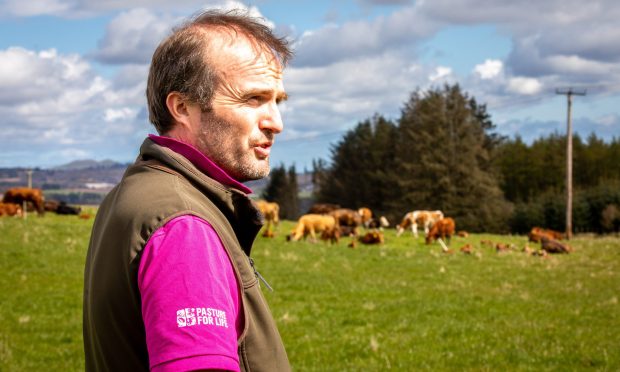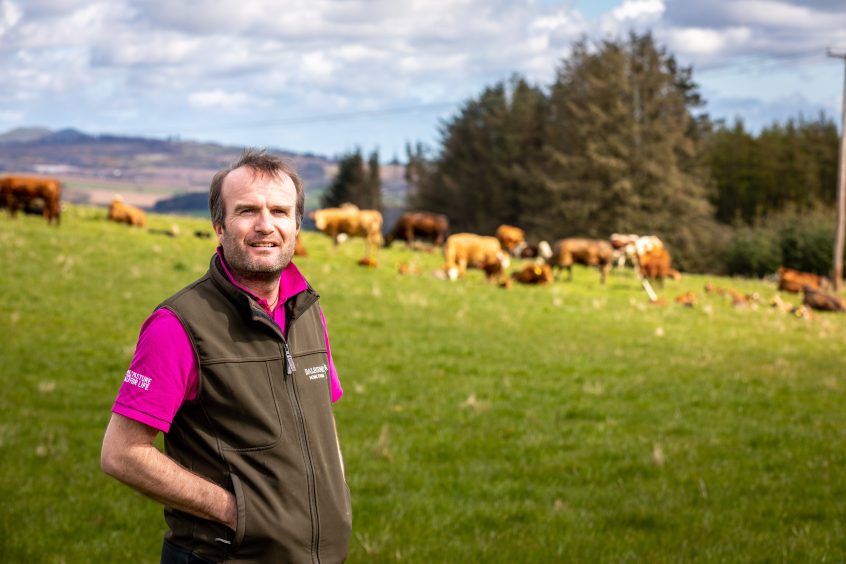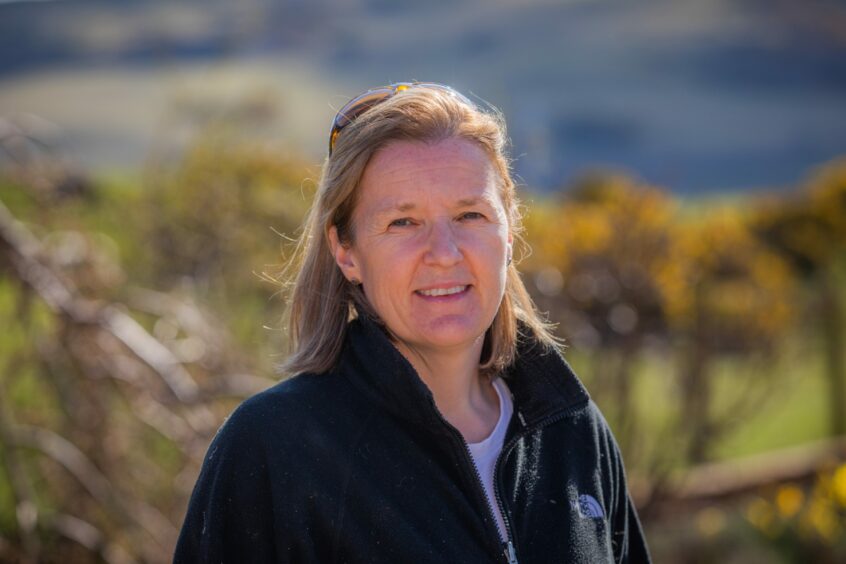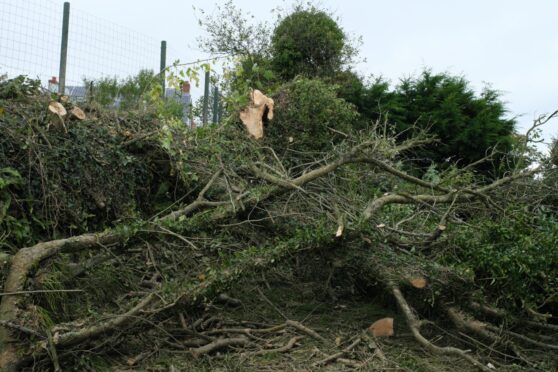Farmers are at the forefront of climate change, dealing with the challenges of unpredictable and changing weather patterns all year round.
This provides added incentive for one Fife farmer who is trying to have a positive impact on the environment.
Johnnie Balfour is a managing partner at Balbirnie Home Farms near Glenrothes.
He is also the chair of Pasture for Life, which encourages farmers to feed their animals a wholly natural diet.
The farm has been in his family for 11 generations and has been ramping up its use of greener farming methods over the past decade.
Johnnie was therefore left disappointed by the Scottish Government’s announcement in April that it would not meet its 2030 emissions target.
The ensuing end of the Bute House Agreement could also jeopardise other previously agreed green policies.
Most farmers would like to improve their carbon footprint, but it can prove challenging.
They face narrow profit margins and the other burdens of modern farming.
However, Balbirnie Home Farms is now close to making a profit before subsidies from its farming.
Less is more for Fife farmer when it comes to green farming practices
When I meet Johnnie I’m surprised by the lack of equipment in the extensive Balbirnie farmyard.
He is one of four pasture for life certified farmers in Fife and only has two tractors for producing crops.
“The essence of what we’re doing is we’re not doing very much”, he explains.
“We’re letting nature do more, which is why we only have two arable tractors and one for livestock. It’s about getting animals to do the work.
“Our arable crops that have been in the ground over the winter have all been grazed by sheep. This will reduce the fertiliser used and reduced the fungicide required.”
We jump in Johnnie’s car and he takes us up the east slopes of the Lomond Hills to get a glimpse of his farm animals.
Most of the farm’s cows and sheep live in two separated sections of a vast field.
Sitting at an altitude of around 200 metres, it provides stunning views across the Firth of Forth.
According to Johnnie, the natural methods used to feed the cows means that their first stomachs (rumens) are healthier.
“Everything they eat is either grass standing in a field, silage or a crop of something we’ve grown for them to eat in situ”, says Johnnie.
“The cattle aren’t eating any concentrated feed, so their rumens work differently and they are healthier animals.
“The meat or milk we get off them becomes a source of Omega-3. The meat you get off those animals is better for us as humans.
“If a cow is emitting something (and) it lives for a shorter amount of time, it emits less. But all the stuff a cow is eating is pulling carbon out of the atmosphere.”
Keeping cows outdoors prepares them better for calving
Another feature of Balbirnie’s farmland in the heart of Fife is that its cattle are kept outdoors for long periods in the colder winter months.
Some also live amongst the trees near the Old Kirkforthar Brickworks.
“They are absolutely cock-a-hoop to be in the trees because suddenly they’ve got scratching posts and they start eating all the leaves off them”, says Johnnie.
“In a shed they are living in their faeces, so the chance of disease is much higher.
“When we get to calving, animals that have been in the shed all winter are couch potatoes.
“And like us humans if you’re a couch potato the chance of having a good birth isn’t as good as if you are fit. It makes it easier for them to have their calves.
“They are burning calories in the shed in order to lose heat, whereas outside they’re burning calories to build muscle.”
The Scottish Government recently decided to retain 70% of direct farm payments for food production.
Johnnie wants to see a change in “mindset” and is critical of government advice.
He believes there needs to be greater incentives for farmers to practice “regenerative” farming.
This means allowing their crops to grow back and potentially improve.
“We’re told that the way to farm better is to make sure the animals are on the farm for the shortest length of time.
“And the way to have them for the shortest length of time is to give them food which has a high concentration of calories in it
“At the moment the advice is based on carbon footprint on a gross carbon basis, rather than a net carbon basis.
“I don’t think we should be getting any money for just farming. If I was doing it I would be incentivising making the transition to regenerative agriculture.”
Ageing farming community trying to make ends meet
Kate Maitland is a farmer based near Newburgh the East Central regional manager for the National Farmers’ Union Scotland.
She can sympathise with the challenges of adopting greener farming practices.
“We have got an ageing profile among the agricultural community and some might be less willing to adapt to change”, explains Kate.
“My understanding is that for the first 2-3 years your income could potentially be negatively impacted while you make that change.
“It’s not really that profitable out there these days. All farmers ultimately are trying to reduce their input costs and trying to make things more profitable.”
When it comes to keeping cows outside, Kate can also see the benefits.
“It very much depends on the ground and the circumstances that you have as to whether you have the capability to do it.
“There are positives and negatives to both. Keeping them outside means the health is potentially higher because they are exposed to less bugs.
“Some people would argue that it is less labour intensive because the methods that you use will be less manual depending on the set-up of your sheds.
“Indoor you are having to bed them, so you’ve got the straw bedding costs.
“But again I think it’s down to individual farms and whether the farmer has got the capability.
“There is a degree of investment too and not all farms have that ability to go down that route.”
Not all ground in Fife suitable for greener farming methods
She continues: “Not all ground in Fife or in Scotland is as suitable for regenerative type farming methods.
“It is all very much down to an individual basis and the type of soil you have.
“You have to plough up the soil because a lot of the root crops need depth. Vegetable farming often has to be done in a more traditional manner.
“Regenerative farming is not suitable for all and there is a conversion period. You may find that the crops don’t yield as well at the start.”
Scottish Government recognises green farming benefits
A Scottish Government spokesperson said: “There need be no contradiction between producing high-quality food and doing so in ways that benefit biodiversity gain and action towards climate adaptation.
“We recognise the benefits of regenerative farming practices, while also supporting improved efficiency.
“We are currently working to develop future support mechanisms which can support the delivery of outcomes linked to lowering emission intensity from livestock.”














Conversation